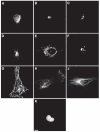A graphical model approach to automated classification of protein subcellular location patterns in multi-cell images
- PMID: 16504075
- PMCID: PMC1489953
- DOI: 10.1186/1471-2105-7-90
A graphical model approach to automated classification of protein subcellular location patterns in multi-cell images
Abstract
Background: Knowledge of the subcellular location of a protein is critical to understanding how that protein works in a cell. This location is frequently determined by the interpretation of fluorescence microscope images. In recent years, automated systems have been developed for consistent and objective interpretation of such images so that the protein pattern in a single cell can be assigned to a known location category. While these systems perform with nearly perfect accuracy for single cell images of all major subcellular structures, their ability to distinguish subpatterns of an organelle (such as two Golgi proteins) is not perfect. Our goal in the work described here was to improve the ability of an automated system to decide which of two similar patterns is present in a field of cells by considering more than one cell at a time. Since cells displaying the same location pattern are often clustered together, considering multiple cells may be expected to improve discrimination between similar patterns.
Results: We describe how to take advantage of information on experimental conditions to construct a graphical representation for multiple cells in a field. Assuming that a field is composed of a small number of classes, the classification accuracy can be improved by allowing the computed probability of each pattern for each cell to be influenced by the probabilities of its neighboring cells in the model. We describe a novel way to allow this influence to occur, in which we adjust the prior probabilities of each class to reflect the patterns that are present. When this graphical model approach is used on synthetic multi-cell images in which the true class of each cell is known, we observe that the ability to distinguish similar classes is improved without suffering any degradation in ability to distinguish dissimilar classes. The computational complexity of the method is sufficiently low that improved assignments of classes can be obtained for fields of twelve cells in under 0.04 second on a 1600 megahertz processor.
Conclusion: We demonstrate that graphical models can be used to improve the accuracy of classification of subcellular patterns in multi-cell fluorescence microscope images. We also describe a novel algorithm for inferring classes from a graphical model. The performance and speed suggest that the method will be particularly valuable for analysis of images from high-throughput microscopy. We also anticipate that it will be useful for analyzing the mixtures of cell types typically present in images of tissues. Lastly, we anticipate that the method can be generalized to other problems.
Figures









References
-
- Park KJ, Kanehisa M. Prediction of protein subcellular locations by support vector machines using compositions of amino acids and amino acid pairs. Bioinformatics. 2003;19:1656–1663. - PubMed
-
- Chou KC, Cai YD. Prediction and classification of protein subcellular location-sequence-order effect and pseudo amino acid composition. J Cell Biochem. 2003;90:1250–1260. - PubMed
-
- Lu Z, Szafron D, Greiner R, Lu P, Wishart DS, Poulin B, Anvik J, Macdonell C, Eisner R. Predicting subcellular localization of proteins using machine-learned classifiers. Bioinformatics. 2004;20:547–556. - PubMed
-
- Boland MV, Markey MK, Murphy RF. Automated recognition of patterns characteristic of subcellular structures in fluorescence microscopy images. Cytometry. 1998;33:366–375. - PubMed
-
- Murphy RF, Boland MV, Velliste M. Towards a Systematics for Protein Subcellular Location: Quantitative Description of Protein Localization Patterns and Automated Analysis of Fluorescence Microscope Images. Proc Int Conf Intell Syst Mol Biol. 2000;8:251–259. - PubMed
Publication types
MeSH terms
Substances
Grants and funding
LinkOut - more resources
Full Text Sources

